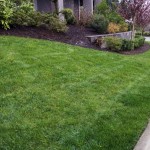Improving poor lawns
Posted on March 3rd, 2009 by Phuong
Proper lawn maintenance and lawn care is one of the best ways to keep your lawn healthy and green, while minimizing weeds. This means assessing the condition of your lawn, and deciding whether de-thatching, aerating and overdressing can help improve its condition.
De-thatching. Thatch is a dense layer of dead and living organic matter that separates grass from the soil surface underneath it. A 1/2-inch layer shouldn’t be a problem, but any thicker than that and thatch can keep air, water and fertilizer from reaching the grass roots. Thatch is usually a mixture of grass stems and roots that accumulates because they’re building up faster than they can break down. Over-watering and applying excessive nitrogen fertilizer can lead to thatch buildup. And contrary to what many people think, leaving grass clippings on the lawn, or “grasscycling,” does not cause thatch buildup. To de-thatch a lawn, Ecoyards will bring in a motorized de-thatcher and remove the thin layer of thatch buildup on your lawn. Then we’ll over-seed (basically add lawn seed) so grass can grow to thicken the lawn in bare areas. 
Aerating. Sometimes your lawn may feel compacted under your foot. That’s because over time, your lawn has become compacted through heavy foot traffic from kids, pets and other activities. Soil compaction essentially squeezes out the pore spaces in the soil that normally holds airs. Roots need oxygen to grow and absorb nutrients and water. When your soil is too compacted, it reduces your lawn’s ability to take in water, nutrients, air and fertilizers. Spring is a great time to aerate your lawn, and Ecoyards provides this service as part of our natural lawn care program. We’ll use a power aerator to remove small plugs of soil from your lawn to improve root development. Left on the lawn, the cores of soil will also help decompose excess thatch layers in the lawn.
Top dressing and over-seeding. After de-thatching or aerating, we often recommend top dressing the lawn with a thin layer of mature compost and planting new grass seed to encourage thicker lawns. Over time, the top dressing benifits the lawn as it builds up the quaility of the soil. For over-seeding, we use a grass mixture that is blended specifically for the Northwest. Thick lawns discourage weeds by crowding them out.
Filed under:Seattle Landscape Maintenance, Seattle Lawn Care | Permalink |



